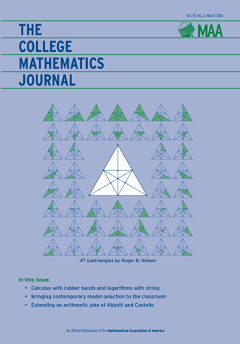- About MAA
- Membership
- MAA Publications
- Periodicals
- Blogs
- MAA Book Series
- MAA Press (an imprint of the AMS)
- MAA Notes
- MAA Reviews
- Mathematical Communication
- Information for Libraries
- Author Resources
- Advertise with MAA
- Meetings
- Competitions
- Programs
- Communities
- MAA Sections
- SIGMAA
- MAA Connect
- Students
- MAA Awards
- Awards Booklets
- Writing Awards
- Teaching Awards
- Service Awards
- Research Awards
- Lecture Awards
- Putnam Competition Individual and Team Winners
- D. E. Shaw Group AMC 8 Awards & Certificates
- Maryam Mirzakhani AMC 10 A Awards & Certificates
- Two Sigma AMC 10 B Awards & Certificates
- Jane Street AMC 12 A Awards & Certificates
- Akamai AMC 12 B Awards & Certificates
- High School Teachers
- News
You are here
College Mathematics Journal Contents—March 2016

Vol 47 No 2, pp 80-160
JOURNAL SUBSCRIBERS AND MAA MEMBERS:
To read the full articles, please log in to the member portal by clicking on 'Login' in the upper right corner. Once logged in, click on 'My Profile' in the upper right corner.
ARTICLES
Rubber Band Calculus
Fred Kuczmarski
We describe a way to visualize functions using rubber bands. Interpreting the derivative as a local stretching factor leads to vivid geometric images for the chain rule, substitution, and curvature, as well as an unusual approach to the fundamental theorem.
To purchase from JSTOR: http://www.jstor.org/stable/10.4169/college.math.j.47.2.82
Proof Without Words: A Surprising Integer Result
Roger B. Nelsen
We wordlessly “prove” that 48 equals 47 and mention a ramification..
To purchase from JSTOR: http://www.jstor.org/stable/10.4169/college.math.j.47.2.94
How to Find the Logarithm of Any Number Using Nothing But a Piece of String
Viktor Blåsjö
We present Leibniz's 1691 recipe for determining logarithms using the catenary and discuss why this odd-looking application in fact made good sense in its historical context.
To purchase from JSTOR: http://www.jstor.org/stable/10.4169/college.math.j.47.2.95
Proof Without Words: Integer Right Triangle Hypotenuses Without Pythagoras
Colin Foster
Without reference to the Pythagorean theorem, we show that a right triangle with legs 3 and 4 has hypotenuse 5. The figure can be modified for other integer right triangles.
To purchase from JSTOR: http://www.jstor.org/stable/10.4169/college.math.j.47.2.101
Integration by the Wrong Parts
William Kronholm
In this article we disregard common sense and good advice and compute antiderivatives for certain functions by stubbornly applying integration by parts infinitely many times.
To purchase from JSTOR: http://www.jstor.org/stable/10.4169/college.math.j.47.2.102
A Canine Conundrum, or What Would Elvis Do?
Michael Maltenfort
The dog Elvis became famous by finding optimal paths that solve various calculus problems. Not all problems, however, have solutions. By giving an unsolvable problem very similar to those Elvis solved, we provide a reminder that it is necessary to prove, rather than assume, that optimal paths exist.
To purchase from JSTOR: http://www.jstor.org/stable/10.4169/college.math.j.47.2.106
Proof Without Words: The Golden Ratio
Roger B. Nelsen
We employ a square with area 5 to determine the golden ratio (without using the quadratic formula).
To purchase from JSTOR: http://www.jstor.org/stable/10.4169/college.math.j.47.2.108
Empirical Modeling: Choosing Models and Fitting Them to Data
Glenn Ledder
Treatments in mathematics books of how to select models and fit them to data have generally not been updated to account for improvements in knowledge and computing over the last 40 years. Here, we offer a derivation of the linear least squares formula that requires only precalculus and use it to develop a simple numerical method for fitting a broad class of nonlinear functions, with results that are far superior to methods in common practice. We also discuss the use of the Akaike information criterion (AIC) to choose among competing models that have been fit to a common data set.
To purchase from JSTOR: http://www.jstor.org/stable/10.4169/college.math.j.47.2.109
Proof Without Words: Powers of Three and Triangular Numbers
C. David Leach
This proof without words presents a series of images that together verify an identity relating powers of three and the triangular numbers.
To purchase from JSTOR: http://www.jstor.org/stable/10.4169/college.math.j.47.2.120
Lattice Paths and Harmonic Means
Marc Zucker
Harmonic means are rarely discussed these days, perhaps because there are few interesting examples of their use. Starting with a question about lattice paths, we present a problem that finds its solution incorporating harmonic means. We also outline the situation beyond two dimensions.
To purchase from JSTOR: http://www.jstor.org/stable/10.4169/college.math.j.47.2.121
Proof Without Words: Arithmetic Mean of Two Means
Ángel Plaza
We provide a visual proof that the arithmetic mean of two positive numbers is greater or equal than the arithmetic mean of the geometric mean and the root mean square.
To purchase from JSTOR: http://www.jstor.org/stable/10.4169/college.math.j.47.2.125
Abbott-and-Costello Numbers
Howard Sporn
We analyze a mathematical routine from the comedy team of Abbott and Costello and determine all possible numbers that could be used in the joke. We determine a recursive formula and a closed-form expression for the resulting integer sequence, both of which use least common multiples.
To purchase from JSTOR: http://www.jstor.org/stable/10.4169/college.math.j.47.2.126
Philip Larkin′s Koan
Paisley Rekdal
To purchase from JSTOR: http://www.jstor.org/stable/10.4169/college.math.j.47.2.133
Classroom Capsules
A Short and Elementary Proof of the Basel Problem
Samuel G. Moreno
By slightly changing a beautiful and little-known argument by E. L. Stark, we give a short and elementary proof of the celebrated Basel problem.
To purchase from JSTOR: http://www.jstor.org/stable/10.4169/college.math.j.47.2.134
De Morgan′s Series Test
C. W. Groetsch
Augustus De Morgan, widely known for his eponymous logic laws, also formulated a little-known convergence test for infinite series in his 1842 calculus textbook. After demonstrating a problem with the original version, we formulate it precisely, bringing it up to date for the modern classroom.
To purchase from JSTOR: http://www.jstor.org/stable/10.4169/college.math.j.47.2.136
Problems and Solutions
Problems and Solutions: 138-145
To purchase from JSTOR: http://www.jstor.org/stable/10.4169/college.math.j.47.2.138
Book Review
How Not To Be Wrong: The Power of Mathematical Thinking By Jordan Ellenberg
Reviewed by: Peter Ross
To purchase from JSTOR: http://www.jstor.org/stable/10.4169/college.math.j.47.2.146
Media Highlights
To purchase from JSTOR: http://www.jstor.org/stable/10.4169/college.math.j.47.2.153





